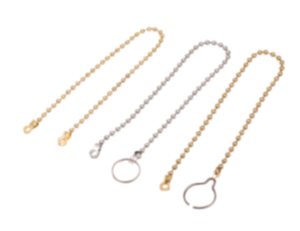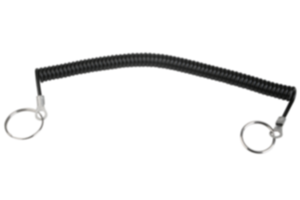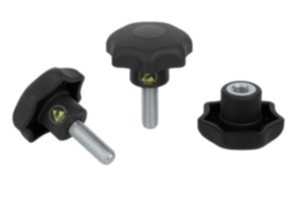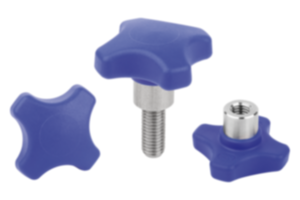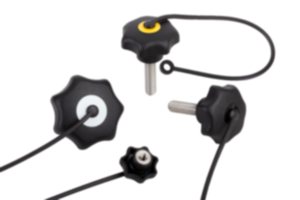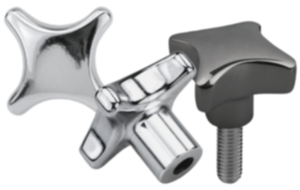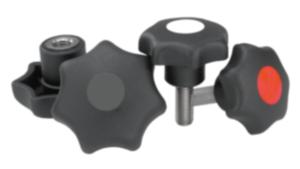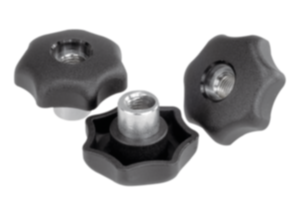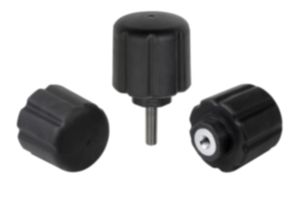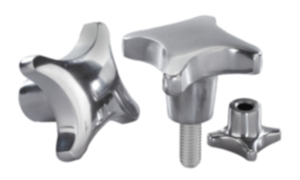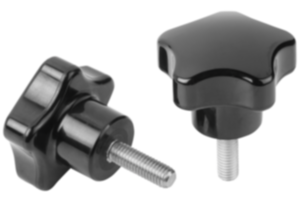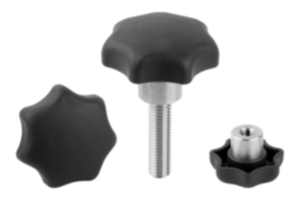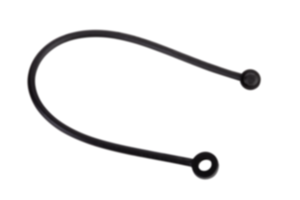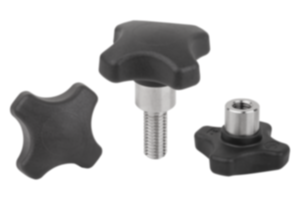Uchycovací čepy / opěrné čepy
Středicí čepy slouží mj. k polohování obrobků a přípravků. Díky kulové koncovce usnadňují proces spojování. Opěrné čepy lze podle tvaru používat buď jako patky nebo jako dosedací plochu pro obrobky a přípravky. Získejte více informací!
Locating pins and rest pads by KIPP
Locating pins and rest pads are operating parts used in mechanics and mechanical engineering. There they are used for positioning and fastening components.
Locating pins, also known as positioning pins, are primarily used to hold components precisely and with repeatable accuracy in a specified position. They are used in fixtures and machine tools to ensure that components are precisely fastened in a specific position. Due to precision manufacturing, they contribute to the accuracy and repeatability of production processes. These properties are particularly important in serial production.
Rest pads, on the other hand, are there to handle and transfer loads. They serve as support points on which components rest or along which they can be moved. Rest pads are used in constructions where stable and secure mounting is required, such as in assembly frames, machine frames or transport devices.
Both types of bolts are crucial for ensuring structural integrity and functionality of mechanical systems. This is why locating pins and rest pads also play an important role in different industries.
In the automotive industry, locating pins are often used in production lines to precisely position and fasten body parts. Rest pads, on the other hand, are important in vehicle production to support and stabilise components during the assembly process.
The mechanical engineering industry also benefits greatly from the use of the two bolts. Locating pins are built into machine tools and production systems to precisely position workpieces. Rest pads are used to support components in machines and improve load distribution.
In addition to the industries mentioned so far, operating parts are also used in the construction industry, electronics industry and precision mechanics. Locating pins and rest pads are indispensable in many industries, as they contribute to the precision, stability and efficiency of manufacturing and assembly processes.
What are locating pins?
Advantages of locating pins
What are rest pads?
Comparing locating pins and rest pads
KIPP your partner for locating pins and rest pads
What are locating pins?
Locating pins are operating parts that are used for the precise positioning of workpieces and components. They play a crucial role in ensuring that components are precisely as well as with repeat accuracy fastened in a specific position. This is particularly important in manufacturing processes where high accuracy and repeatability are required.
Important features of locating pins include:
- Precise positioning: One of the main advantages of locating pins is their ability to position components precisely. The precision achieved is crucial for the quality of the finished products.
- High load rating: Locating pins are designed to withstand high mechanical loads. This is particularly important in industries such as the automotive and aerospace industries, where the bolts are subjected to high forces.
- Various head shapes and materials: In order to met different requirements and operating conditions, locating pins are available with various head shapes and in different materials. This allows flexible customisation to specific applications.
- Corrosion resistance: Locating pins used in environments with corrosive influences must be corrosion-resistant. This is achieved by using materials such as stainless steel or special coatings that protect the pins from rust and other forms of corrosion. This is particularly important in aerospace and offshore industries.
The KIPP product range offers many different locating pins and matching accessories:
- Locating pins with ball end Form A
- Locating pins with ball end Form B
- Locating pins with internal thread
- Locating bushes for locating pins
Advantages of locating pins
Using locating pins offers a number of advantages that makes them particularly valuable in different industrial sectors. The most important advantages include:
- Improvement of production accuracy
- Reduction of downtimes through easy installation and replacement
- Long service life in challenging environments
- Available with various types of head to meet different application requirements
Locating pins significantly contribute to boosting production accuracy. Their ability to position components precisely ensures that all parts of a product are correctly aligned and assembled. The use of locating pins guarantees that manufacturing processes meet consistently high quality standards, which increases performance and reliability of the final products.
Another advantage of locating pins is their easy installation and replacement, resulting in reduced downtime. In industrial production environments, minimising downtime is crucial to maximising efficiency and productivity. Locating pins can be installed or replaced quickly and easily without the need for extensive adjustments or special tools. This makes maintenance work and repairs much easier and helps to ensure that production runs smoothly and without lengthy interruptions.
The availability of locating pins with various head shapes - cylindrical, conical, spherical - enables optimum customisation to specific fastening and positioning requirements. This variety ensures that the right solution can be found for every application, maximising functionality and efficiency of the pins. Cylindrical pins, for example, offer simple and stable fastening, while conical pins can facilitate a more precise alignment.
To summarise: Locating pins offer considerable advantages that make them crucial components in many industrial applications.
What are rest pads?
Rest pads are operating parts that are used in industry and mechanical engineering to position, support or fasten workpieces or components. They serve as support points and help to ensure stability and accuracy of components during machining or assembly.
Typical applications and areas of use are:
- Machine tools and production plants: Rest pads are used in CNC machines, milling machines and lathes to securely fasten and precisely position workpieces. They help to keep workpieces stable during machining and minimise vibrations.
- Assembly and production devices: Rest pads are used in devices that have to hold workpieces in the correct position during assembly. Operating parts are used to precisely align components and ensure that they do not slip during assembly.
- Measuring and test fixtures: In measuring fixtures, support pins help to position workpieces accurately to facilitate precise measurements. In test fixtures, the parts are used to hold workpieces firmly and stably during quality control.
Rest pads are essential components in industry and mechanical engineering. They provide a firm contact face for workpieces and ensure a stable base for machining and assembly processes. Due to their sturdy design, they prevent workpieces from slipping or tilting, which is particularly important for achieving precise and high-quality results. They also help reduce vibrations by providing stable support, which leads to better machining quality and extends the service life of the tools.
Rest pads are often made of high-strength materials such as hardened steel or special alloys that can bear high loads. They are designed to absorb large forces and distribute them evenly, allowing even heavy workpieces to be held securely. This makes them perfect for heavy duty applications in areas such as the automotive and aviation industries.
Another important feature of rest pads is their height adjustability. This makes it possible to adjust the height of the contact face to different workpieces and processing requirements. The flexibility of adjustable rest pads is particularly useful in production processes where workpieces with different heights and of different types need to be machined.
Rest pads are available with different head shapes to support different requirements. Flat heads provide a wide and stable contact face, spherical heads allow a certain degree of mobility and adjustment to uneven surfaces, and conical heads allow for precise centring and positioning. The pins themselves can also have different shapes and thread types to fit into different brackets or fixtures.
The following pins are available from the KIPP range:
- Rest pads made of tool steel
- Pins with contact sensor
- Rest pads according to DIN 6321
- Pins with QT steel body
- Rest pads with positioning pin
- Pin-style rest pads with internal or external thread
Comparing locating pins and rest pads
Both pins are essential components in machine technology that are used for the positioning and fastening of workpieces or components. Both locating pins and rest pads are used to securely fasten and precisely position components. They are made of sturdy materials such as steel or hardened stainless steel to withstand high mechanical loads. Both pin types can be manufactured in various sizes and designs to meet specific requirements. Another common feature is their importance for the safety and reliability of machines and structures, as they help to ensure stability of the entire structure.
Despite their similarities, however, there are significant differences in function and application.
The primary difference between locating pins and rest pads lies in their specific function and area of application. Locating pins are primarily intended to hold workpieces and adjust them in a specific position. They are often used in fixtures where parts need to be changed quickly or positioned precisely. Locating pins typically have a conical or cylindrical shape that makes it easy to fit and hold parts.
Rest pads, on the other hand, are mainly used to support components and provide a stable contact face. They are used to ensure even load distribution and prevent deformation or damage to the components. Rest pads usually have a flat or rounded surface that ensures optimum support. They are often used in areas where components are stationary or need to be supported during the machining process.
Correct selection and mounting of operating parts directly influences efficiency, safety and precision of the entire system. So you have to b aware of your specific requirements when making your selection.
KIPP your partner for locating pins and rest pads
KIPP is one of the leading manufacturer of standard elements, operating parts and clamping technology. We are known for the extraordinary quality of our products. These are made of high-quality materials and are subject to strict quality controls to ensure that they meet the highest industry standards.
Due to many years of experience in the industry, KIPP can draw on in-depth knowledge and technical expertise. As KIPP-Customers you benefit from the expertise and innovative solutions that we continually develop.
Do you have any questions about our locating pins and rest pads or need further information?





